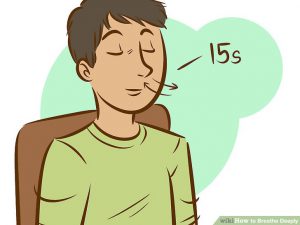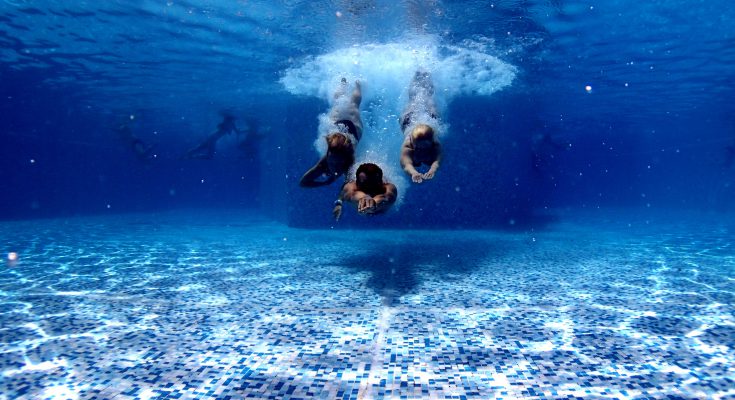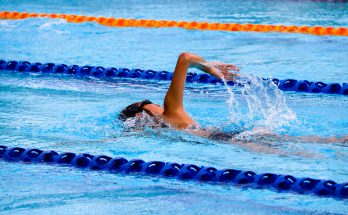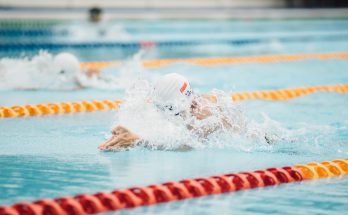Beginner and Intermediate swimmers can be challenged and even frustrated when learning the breathing technique for the freestyle stroke. For one, the head is submerged in the water for at least 1-3 seconds on a stroke. This can lead some swimmers to take in water and choke. Others may hyperventilate and panic. While still others may compromise their swimming posture and begin to sink. None of these scenarios are ideal. The truth is, without proper technique, training and practice, it’s nearly impossible to achieve the breathing aspect of this stroke.
Whether a swimmer is taking lessons or simply learning on their own, they must become comfortable enough in the water in order to master this breathing technique. Otherwise, this will continue to be a problem. If you are experiencing this issue, please continue to read and hopefully, this post will be of some service to you.
The Basic Freestyle Swimming Technique
Please allow me to spell out the basic freestyle breathing technique for those who have never taken a swimming lesson in their life and truly are unaware of how breathing while swimming works.
 With swimmer’s legs out behind them, one or both arms stretched out in front, swimmer’s head in the water, face submerged and parallel to the pool floor, the swimmer exhales through the nose or mouth. DO NOT HOLD YOUR BREATH; but BREATH OUT slowly. Exhaling this way in the water will create bubbles, as seen in the picture above.
With swimmer’s legs out behind them, one or both arms stretched out in front, swimmer’s head in the water, face submerged and parallel to the pool floor, the swimmer exhales through the nose or mouth. DO NOT HOLD YOUR BREATH; but BREATH OUT slowly. Exhaling this way in the water will create bubbles, as seen in the picture above.
 In this stroke, swimmer lifts the right or left arm up and over, and at the same time tilts the head to the same side of the lifted arm. Please note that the elbow cracks the water first, then the hand sweeps around from the side of the body to out in front of the head. If the swimmer turns their head to the right, their left ear should remain in the water. If the swimmer turns to the left, their right ear should remain in the water. This positioning of the head is important because if the swimmer lifts their head too far out of the water, proper prone positioning may be loss, and there is a tendency for the legs to sink. Imagine lying down on your side with the legs only twisting slightly to the right/left, with your body staying as much as possible up and to the surface of the water. In this position, swimmer inhales through the nose or mouth. Try breathing in as normally as possible. You have from the time the head tilts out of the water until the lifted arm stretches out in front of the body.
In this stroke, swimmer lifts the right or left arm up and over, and at the same time tilts the head to the same side of the lifted arm. Please note that the elbow cracks the water first, then the hand sweeps around from the side of the body to out in front of the head. If the swimmer turns their head to the right, their left ear should remain in the water. If the swimmer turns to the left, their right ear should remain in the water. This positioning of the head is important because if the swimmer lifts their head too far out of the water, proper prone positioning may be loss, and there is a tendency for the legs to sink. Imagine lying down on your side with the legs only twisting slightly to the right/left, with your body staying as much as possible up and to the surface of the water. In this position, swimmer inhales through the nose or mouth. Try breathing in as normally as possible. You have from the time the head tilts out of the water until the lifted arm stretches out in front of the body.The Truth About Swimming & Breathing
 Please consider this truth, because we all know how to breath, for those who struggle with this technique, breathing is not really the problem. So, let’s take some of the issues one at a time and give them a real solution.
Please consider this truth, because we all know how to breath, for those who struggle with this technique, breathing is not really the problem. So, let’s take some of the issues one at a time and give them a real solution.
- Swimmers complaint: Taking in water while swimmer is inhaling.
-
- This occurs in one of two ways. As the swimmer’s head clears the water’s surface on the inhale, sometimes the nose and mouth still have water in them. Think of a glass filled with liquid that we try emptying by shaking it out. Usually the glass will still have some liquid in it until we either wipe or dry clean. Similarly, swimmers suck in residual water left in these areas together with air. This issue can also occur when swimmers do not completely clear the surface of the water then inhale while they are, in fact, still under water.
- Solution: Once swimmer’s mouth and nose clear the surface of the water, continue exhaling for a 10th of a second before inhaling. Continuing to exhale once the nose and mouth hit the water’s surface will empty the system of that last bit of water that remains there. Also, be sure to turn the head far enough to clear the surface of the water. Swimmers can turn their heads to the side and look towards their feet, if simply turning to the side still proves to be a problem.
The better a swimmer stays afloat or as close to the surface as possible, the better they will be at inhaling above the water without taking in water. So, work on gliding through the water on every stroke. Try this pattern; stroke/glide/stroke/glide, etc. On the glide, the head goes underwater and the swimmer releases air slowly on an exhale.
2. Swimmer’s complaint: Expelling air from the body too quickly while exhaling underwater.
-
- In this condition, swimmers blow out all the air they have in their lungs as soon as their heads go underwater. Therefore, swimmer has to come back up for air quickly. Swimmer’s positioning and rhythm can be thrown off, together with their balance if they are prone to panic.
- Solution: Swimmers can try humming underwater in order to allow the breath to come out more slowly and evenly.
3. Swimmer’s complaint: Swimmer is nervous with their head underwater.
-
- This condition occurs when swimmer is overwhelmed with a fear of drowning.
- Solution: Most times, this complaint can work itself out for beginners simply by them getting used to being in the water. Also, try learning the breast stroke. With this stroke, swimmers lift their entire head out of the water in order to take a breath and swimmer has more control on how long they wish to remain underwater, without sacrificing form. The breast stroke is sometimes referred to as a rest stroke. It’s a great stroke for getting used to being in the water.
True Muscle Memory?
Regarding muscle memory, there are several theories, some saying there is such a thing, while others seek to disprove the notion. Both sides, however, agree that there is memory within the body, possibly in the nerves of our muscles and in parts of our brains that recall movement so that we don’t have to keep relearning certain actions over and over again. We see this in things like walking, bike riding and even swimming. We’ve learned how to do these activities and even if we’ve been away from them for an extended period of time, barring we haven’t suffered a major injury, chances are we can perform them again without another lesson.
“Although new results suggest that the muscle cells themselves do not retain a “memory” from exercise, the same is not true for the nerves that thread through the muscles, or the brain regions that control movement… Your nerves have learned in which order to activate your muscles in order to perform a certain movement,” Lindholm said. https://www.livescience.com/56…

How To Use Body Memory for Swimmer’s Breathing Technique
PRACTICE SWIMMER’S BREATHING TECHNIQUE OUTSIDE OF THE WATER! Whether there is memory stored in our muscles or nerves or regions of our brains, we can use this information to our advantage. We can improve how our bodies will execute this movement in the water, by doing it over and over again on solid ground. Many coaches implement this exercise for beginner swimmers. Swimmers can sit and just exhale slowly, turn their head to the right/left and inhale quickly, then turn head back center and exhale slowly, etc. If swimmer is feeling ambitious, lie down and put the arm movements and leg kick action together for the freestyle combination and include the breathing.
This is my favorite, favorite advice to swimmers with breathing issues! I’ve put it in several posts because it actually works! Try doing this while you’re watching television, doing household chores, etc. for an entire month. Then get into the shallow end of the pool and give it a whirl. You’ll be amazed at how much improved you’ve become.
Please leave a comment below if you like what you’ve read in this post.





Hello there! I just got into my swimming lessons and I’m having a hard time with my breathing. I haven’t talked about this to my instructor yet but so far he’s teaching me the basics. Luckily, I found your article that talks about on how to stop breathing problems when swimming. I will surely follow this tips and guides and ask my coach if the problem still occurs. Thank you for sharing this.
I’m so glad this was helpful to you, John. You will see a great deal of improvement in your breathing when you practice outside of the water. Good luck and Go Swim! Bev-